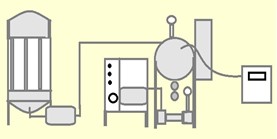การศึกษาการอบแห้งกล้วยดิบโดยใช้เทคนิคความดันต่ำร่วมกับการใช้ไอน้ำยิ่งยวด | Study of Drying Raw Banana by Vacuum Cooperate with Superheated Steam Technique
Main Article Content
Abstract
The purpose of this study was to design drying process using superheated steam under low-pressure. The optimal condition for banana drying was also determined. Raw bananas were sliced in disk shape with 5 mm thickness and placed in the chamber. At the first stage of drying, banana pieces were dried under vacuum at -55 cmHg for 20, 40, 60, 80 and 120 minutes then superheated steam at 170, 180 and 190 degrees Celsius were applied into the drying chamber. The physical properties of bananas i.e., moisture content, color and fracture force were examined and used as quality indices to determine the optimum conditions of drying. The result showed that, moisture contents were 6.73-27.82% for vacuum drying 60-80 minutes at 170 degrees Celsius of superheated steam, 4.21-21.51% for vacuum drying 60-80 minutes at 180 degrees Celsius of superheated steam and 12.68-31.35% for vacuum drying 40-60 minutes at 190 degrees Celsius of superheated steam. The color values of dried bananas obtained from drying under all conditions were not different. The maximum fracture forces of dried bananas were 95 N, 60 N and 65 N at superheated steam temperature of 170, 180 and 190 degrees Celsius, respectively. The optimal superheated steam temperature in this research was 190 degrees Celsius by considering from the short time of drying and the quality indices were not different from the other conditions with short time.
บทคัดย่อ
งานวิจัยนี้มีวัตถุประสงค์เพื่อการออกแบบกระบวนการอบแห้ง ที่สภาวะความดันต่ำร่วมกับการใช้ไอน้ำยิ่งยวด และศึกษาสภาวะที่เหมาะสมสำหรับการลดความชื้นกล้วย เริ่มจากการนำกล้วยดิบที่หั่นเป็นแว่น
หนา 5 มิลลิเมตร เข้าตู้อบแห้งสุญญากาศที่ความดัน -55 เซนติเมตรปรอท เป็นเวลา 20 40 60 80 120 นาที หลังจากนั้นปล่อยไอน้ำยิ่งยวดที่อุณหภูมิ 170 180 และ 190 °C นำกล้วยที่ผ่านการอบแห้งมาตรวจสอบคุณภาพเพื่อหาสภาวะที่เหมาะสม จากการทดลองพบว่าที่อุณหภูมิไอน้ำยิ่งยวดที่ 170 °C ใช้เวลาในการอบแห้งสุญญากาศ 60-80 นาที มีค่าความชื้น 6.73-27.82 % อุณหภูมิไอน้ำยิ่งยวดที่ 180 °C ใช้เวลาในการอบแห้งสุญญากาศ 60-80 นาที มีค่าความชื้น 4.21-21.51% และอุณหภูมิไอน้ำยิ่งยวดที่ 190 °C ใช้เวลาในการอบแห้งสุญญากาศ 40-60 นาที มีค่าความชื้น 12.68-31.35% จากการวัดค่าสีพบว่ากล้วยที่ได้จากการอบแห้งในทุกสภาวะมีค่าสีใกล้เคียงกัน เมื่อทดสอบแรงกดที่ทำให้แตกหักพบว่ากล้วยที่ผ่านการอบแห้งด้วยการใช้ไอน้ำยิ่งยวดที่อุณหภูมิ 170 °C ใช้แรงกดสูงสุด 95 นิวตัน หากใช้ไอน้ำยิ่งยวดที่อุณหภูมิ 180 °C ใช้แรงกดสูงสุด 60 นิวตัน และเมื่อใช้ไอน้ำยิ่งยวดที่อุณหภูมิ 190 °Cใช้แรงกดสูงสุด 65 นิวตัน ดังนั้นการอบแห้งที่สภาวะที่เหมาะสมจึงใช้อุณหภูมิในการอบแห้ง ที่ 190 °C เพราะใช้เวลาในการอบแห้งที่สั้นกว่า และ ค่าคุณภาพอื่นๆ ไม่มีความแตกต่างกัน
Downloads
Article Details
References
12 มีนาคม 2557, สืบค้นจาก www.ic.kmu
tnb.ac.th/webpage/subject/.../chapter%202%20dry.pdf
รุ่งนภา พงศ์สวัสดิ์มานิต. (2536). วิศวกรรมแปรรูปอาหาร. นครปฐม: โอเดียนสโตร์.
วิไล รังสาดทอง. (2546). เทคโนโลยีการแปรรูปอาหาร (พิมพ์ครั้งที่ 3). กรุงเทพฯ: เท็กซ์ แอนด์ เจอร์นัล.
สักกมน เทพหัสดิน ณ อยุธยา. (2008). การอบแห้งอาหารด้วยไอน้ำร้อนยวดยิ่งที่สภาวะความดันต่ำ. สืบค้นเมื่อ 21 พฤศจิกายน 2555, สืบค้นจาก http://www.vcharkarn.com/ varticle/38207
Arsdel, V. (1963). Food dehydration. Principles. Food dehydration. Volume I. Principles.
Barbieri, S., Elustondo, M., & Urbicain, M., (2004). Retention of Aroma Compounds in Basil Dried with Low Pressure Superheated Steam, Journal of Food Engineering, 65(1), 109-115.
Davahastin, S., Suvarnakuta, P., Soponronnarit, S., & Mujumdar, A. S. (2004). A Comparative Study of Low-pressure Superheated Steam and Vacuum Drying of a Heat-sensitive Material. Drying Technology, 22(8), 1845-1867.
Food Network Solution Co., Ltd. (2010).
การทำแห้ง. สืบค้นเมื่อ 7 ธันวาคม 2555, สืบค้นจากสืบค้น http://www.foodnetwork
solution.com
James, J. M., Loessner, M. J., & Golden, D. A. (1998). Modern Food Microbiology. Massachusetts, USA: Spinger science business media.
Methakhup, S., Chiewchan, N., & Devahastin, S. (2005). Effects of drying methods and conditions on drying kinetics and quality of Indian gooseberry flake. LWT-Food Science and Technology, 38(6), 579-587.
Suvarnakuta, S., Davahastin, S., & Mujumdar,
A. S. (2005). Drying Kinetics and β-carotene Degradation in Carrot Undergoing Different Drying Processes. Journal of Food Science, 70(8), 520-526.
Thomkapanich, O., Suvarnakuta, P., & Devahastin, S. (2007). Study of intermittent low-pressure superheated steam and vacuum drying of a heat-sensitive material. Drying Technology, 25(1), 205-223.

